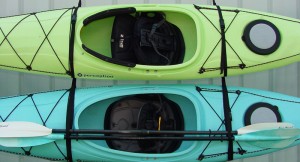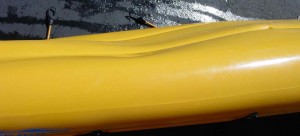So…Have you had a conversation with your kayak this winter?
Sure, we all tend to lavish attention, praise and some even a dose of abuse on our plastic and composite friends during the warm and sunny days of the paddling season; but when was the last time you sat down with your kayak to talk about the upcoming Red Sox season? Dusted her off? Played her favorite piece of jazz? Or even re-positioned her on her cradles or hanging straps.
You know who you are…Shame on you!!
Kayak Dave’s post of kayak thefts and safeguarding your kayak led me to think of storage and longevity; but first let me tell you of a lesson well learned. Twenty-two summers ago, I purchased my first RM (plastic) sea kayak, a Wilderness Systems Alto. When I got home I cleared off a 5’ workbench in my garage and laid my new 15’ Alto on top of it. The good thing was that it was out of the sun and out of sight of nefarious eyes. The not so good thing was that 5’ of kayak were hanging off each end of the hard wooden bench. It was summer so the garage temperatures were probably in the low 80’s during the day. When I went to paddle it 3 or 4 days later; I was shocked to see that the rocker in the middle section was noticeably flatter than it should have been!
There are a few lessons to take away from this:
#1. Rotomolded (plastic) kayaks are essentially dynamic materials that are impacted by heat, sun, and tension or forces exerted upon it. Several times each season, we will try to cover our smiles when we see a customer drive into the kayak shop with an over-tightened kayak on the roof of their vehicle that resembles a banana more than a kayak. Also, it is normal for older plastic kayaks to develop undulations on their hulls over time. At the kayak shop we refer to these wavy hulls as having “wows” on them. These undulations rarely compromise the integrity or the longevity of the hull. Many of the shops’ rental kayaks have “wows’ to them and are safe and useable for many seasons.
#2. Composite and thermoformed kayaks have greater structural integrity and rigidity/stiffness than plastic RM kayaks possess. (Note: Thermoform plastic kayaks resist warping in the summer better than do roto-molded kayaks BUT are more prone to cracking in the Winter when low temperature make the material more brittle).
#3. Composite and roto-molded kayaks tend to have the greatest structural integrity and rigidity when stored on edge and with supports approximately 1/3 of the way in from bow and stern and/or roughly where the forward and aft bulkheads are located. (Note: I am not sure if it is necessary; but I will reposition my RM and composite kayaks that are hanging by straps in my heated garage a couple of times during the long off-season; by changing the direction they are stored or by moving the straps 6” fore and aft.)

A good example of properly hanged kayaks. Straps are located at 1/3 points (over bulkheads) and kayaks are on edge.
#4. Plastic has a degree of “memory” to it which simply means that it wants to return to the shape of the mold in which it was created, over a period of time. The good news is that if you leave your “warped” plastic kayak out in the sun on a flat grassy surface for a period of time it will strive to return to its original shape (but never 100% there). Check it every 15 minutes or so over the course of an hour. If it has not changed in an hour it most likely will not. Others paddlers have recommended the cautious use of a hair dryer or heat gun on a low temperature setting to carefully and judiciously heat the affected area by warming the broader area of involvement and gently pushing with your hand on the target area of concern. Obviously, you need to be careful not to heat so much as to burn your hand on the warmed plastic or to melt the plastic nor set on fire your beloved kayak. Others have suggested pouring “warm water” into the targeted area. Having a kayak with bulkheads makes this approach more doable and the heat distribution is more uniform with the use of water than the use of a focused artificial heat source. PLEASE use great caution when carrying heated water. Water coming out of the faucet is more than hot enough. Common sense and caution are the key words here
So…if you have yet to have a conversation with your kayak this winter then maybe it’s time to go say “Hello!”
-Boreal Alvik




3 Responses to Kayak Storage Tips